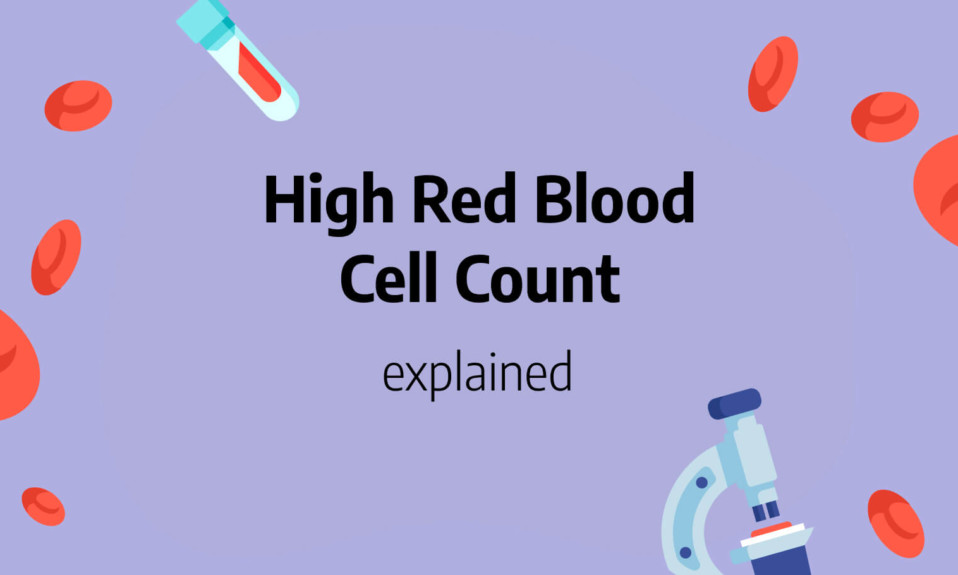What are red blood cells?
Red blood cells or erythrocytes are cells without a nucleus that circulate in the blood.
They transport oxygen to the cells and release carbon dioxide.
Red blood cells are essential for life. Each red blood cell contains hemoglobin, an iron-rich protein.
Hemoglobin is a protein that transports oxygen from the lungs to the body’s various organs and removes carbon dioxide from the organs to the lungs. Hemoglobin provides the red color of blood. Hemoglobin contains 65% of the body’s iron stores. The calculation of red blood cells allows the detection of certain pathologies such as anemia.
What is considered a high red blood cell count?
High red blood cell count or erythrocytosis is when the number of red blood cell count exceeds a certain level.
Men: RBC count shouldn’t exceed 6.1m/mm3. Above this level, we consider the red blood cell count elevated.
Women: RBC count shouldn’t exceed 5.5m/mm3. Above this level, we consider the red blood cell count elevated.
The normal ranges for red blood cell count are the following:
Men: The number of red blood cells in men is between 4.5 and 6 million/mm3 with a hemoglobin between 13 and 18 g/100 dl.
Women: The number of red blood cells in women is between 4 and 5.4 million/mm3 with a hemoglobin of about 14 g/100 dl. These numbers are decreased in a pregnant woman.
Babies and Children: In babies, the number of red blood cells is about 5.8 million/mm3 and the hemoglobin is about 13 to 16 g/dl. In children, the number of red blood cells is between 3.6 and 4.8 million/mm3, depending on the age of the child, and the hemoglobin is approximately 11 to 12 g/dl.
What causes a high red blood cell count?
If the numbers are higher than normal, polycythemia may be suspected.
Polycythemia is an increase of red blood cells in the blood.
A distinction is made between primary polycythemia, which is caused by an exacerbation of the function of the bone marrow that produces red blood cells, and secondary polycythemia.
Sometimes we also talk about polycythemia vera (primary and secondary).
Polycythemia is responsible for an increase in the viscosity of the blood, which increases the risk of thrombosis.
High red blood cell count can be caused by many factors like :
- Lung disease
- Altitude
- Smoking
- Birth defected of the heart
- Liver tumor
- Genetic disorders
- Hormonal treatments (testoterone)
- Carbon monoxide poisoning
Sometimes, a simple increase in the RBC level is possible, without it being polycythemia: smoking, obesity, hypertension, alcoholism, excessive stress… can lead to an increase in this level.
What are the symptoms of high red blood cell count?
High red blood cell count doesn’t always show symptoms. You can have elevated red blood cell count for months or years without noticing it.
However, erythrocytosis‘s symptoms can be the following:
- Weakness
- Dizziness
- Fatigue
- Shortness of breath
- Headeache
- A sensation of completion just after you eat, or bulging or torment in your left upper midsection (in light of an extended spleen)
How to diagnose high red blood cell count?
Usually, doctors perform a complete blood count test (CBC test) to analyze your number of red blood cells.
You’ll then get your number and easily see if something is wrong with your blood cells.
Can dehydration cause high red blood cell count?
Yes dehydration increases the number of red blood cells. The number of red blood cell will also be more concentrated.
How to treat elevated red blood cell count?
Treatment methods exist to lessen the effects of polycythemia.
Regular blood sampling can be done to reduce the number of red blood cells.
Specific medications can also be given to reduce complications by reducing the production of platelets.
With proper treatment, a person with polycythemia or elevated red blood cell count can live for many years with mild to moderate symptoms.
It is important to note that treatment does not permanently cure polycythemia, but it slows its progression and reduces its complications. For example, it prevents the regular formation of blood clots.
Other treatment methods include bone marrow transplantation.
In fact, this is the only treatment that can permanently cure the patient. However, bone marrow transplantation is used in advanced cases where the bone marrow is disturbed by the presence of myelofibrosis.
High red blood cell count diagnosis and medical evaluation
To diagnose high red blood cell count, healthcare professionals utilize various diagnostic tests and medical evaluations.
The primary tool for evaluation is a complete blood count (CBC), which measures the number of red blood cells, hemoglobin levels, and hematocrit (the percentage of blood made up of red blood cells).
Abnormal results from the CBC may prompt further investigations.
Additional tests may include genetic testing to identify any underlying genetic disorders related to high RBC count, a bone marrow biopsy to examine the production of blood cells in the bone marrow, and imaging studies to assess the overall health of organs such as the kidneys and liver.
It is crucial to consult with a healthcare professional to undergo these tests and receive an accurate diagnosis.
Treatment Options for High Red Blood Cell Count
The treatment of high red blood cell count aims to reduce the excessive number of red blood cells in the body and manage the underlying cause.
One of the primary treatment methods is therapeutic phlebotomy, which involves the removal of excess blood from the body.
This process helps to lower the red blood cell count and alleviate symptoms.
The frequency and duration of phlebotomy sessions are determined by the severity of the condition and the patient’s response to treatment.
In addition to phlebotomy, medications may be prescribed to regulate red blood cell production.
Hydroxyurea, a medication commonly used, helps to decrease the production of red blood cells.
Other drug options may be considered depending on the underlying cause and individual patient factors.
Furthermore, lifestyle modifications such as dietary changes, smoking cessation, alcohol moderation, and regular exercise can contribute to managing high RBC count and improving overall health.
High red blood cell count prevention and outlook
While it may not be possible to prevent all causes of high red blood cell count, there are certain measures individuals can take to minimize the risk.
First and foremost, adopting a healthy lifestyle that includes regular exercise, a balanced diet, and abstaining from smoking and excessive alcohol consumption can help maintain normal red blood cell levels.
Additionally, individuals at risk of chronic hypoxia due to certain occupations or residing at high altitudes should take necessary precautions, such as ensuring adequate ventilation and oxygenation.
It is important to note that early detection, proper diagnosis, and timely treatment play a crucial role in managing high red blood cell count and preventing potential complications.
Regular monitoring and follow-ups with healthcare professionals can help individuals maintain a healthy red blood cell count and overall well-being.
Understanding High Red Blood Cell Count: Causes, Symptoms, and Treatment
Red blood cells (RBCs) play a vital role in transporting oxygen throughout the body, but an abnormally high red blood cell count can indicate underlying health concerns. A high RBC count, known as erythrocytosis or polycythemia, occurs when the body produces too many red blood cells, leading to thicker blood and potential complications such as blood clots or reduced circulation.
This condition can be triggered by factors like chronic lung disease, heart conditions, high altitude adaptation, or excessive production of erythropoietin—a hormone that regulates red blood cell production. Dehydration can also temporarily increase RBC concentration by reducing plasma volume rather than increasing actual cell production. Symptoms of high RBC levels may include dizziness, headaches, fatigue, and shortness of breath. Diagnosis typically involves blood tests, and in some cases, further evaluation such as bone marrow analysis or genetic testing may be required. Treatment depends on the underlying cause but can include therapeutic phlebotomy (blood removal), medication to suppress RBC production, or addressing conditions that contribute to the elevation.
Preventative measures such as staying hydrated, managing underlying health conditions, and avoiding smoking can help regulate red blood cell levels and reduce associated risks.










